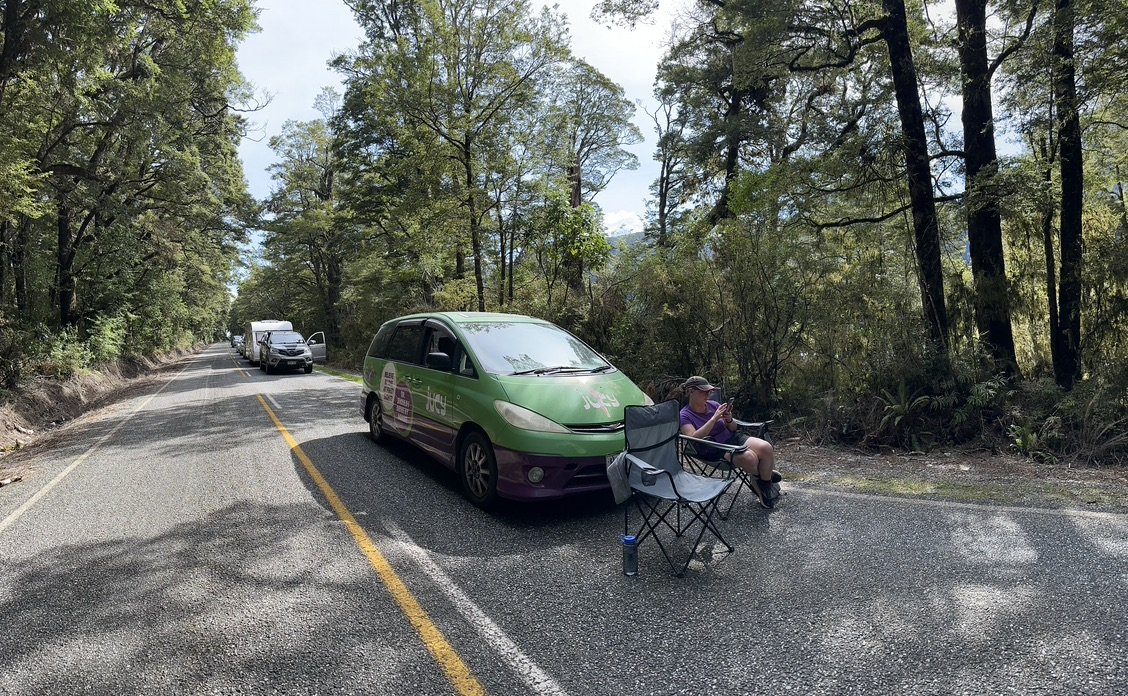Campervanning in New Zealand
In January 2023, we spent 14 days campervanning in New Zealand while driving one way from Queenstown to Auckland. Campervanning is a super popular way to travel in NZ, and especially on the South Island, there are seemed to be more campervans on the road than regular vehicles.
After completing this trip, I’m not sure I would do it again in a campervan. Our trip was successful and we had an excellent time, but there were a few challenges.
We picked up our Jucy Campervan in Queenstown near the airport. The office in Queenstown is pretty small and it was easy to get the shuttle from the airport to the office. It’s also conveniently located near a grocery store, so it is easy to stock up before heading out.
We selected Jucy because they had a Queenstown office and the price was right. We were also fortunate to book about six months in advance in June 2022, just as NZ was reopening and our pricing was much lower than anyone who booked closer to January 2023.
Our van was a converted mid-2000’s Toyota Estima with over 300,000 km. When we first picked it up, I wasn’t sure we would make it all the way to Auckland, but it proved to be a very sturdy vehicle and we had no major issues.
The back and middle seats convert from a bench with table, that we never used, to a bed. And then all the windows are covered with canvas fabric that snaps on, which actually provides a very good screen. In the back there is a small sink with water reservoir and a fridge that is hooked up to a battery. That second battery charges when the van is on. There is one gas burner along with cooking equipment.
We did have a lot of issues with our fridge. Initially it didn’t work at all and we went back to the office the same day we picked it up and they adjusted the fuse which got it to turn on and get cold. But the next morning it wasn’t cold, so we went back again and they spent an hour or so looking it over, this resulted in replacing it with a newer fridge that stayed cold during the day, but once we stopped for the night, it did not continue to run and stay cold, because of this we did not carry anything that needed to stay cold. We ended up eating a lot of eggs which didn’t need refrigeration in NZ and shelf stable soup.
I booked all of our campsites in advance, this generally was a good plan since it was a popular holiday travel time in early January, some campgrounds were full and some of them would have been okay to pull into last minute. We stayed in three different types of campgrounds - Department of Conservation campsites, local campgrounds, and holiday parks.
Henry Creek DOC Campsite
The DOC campsites were super variable, ranging from only a pit toilet to numbered sites with a full service bathroom. Our first was Henry Creek in Fiordland National Park, and it had no running water and a pit toilet. The campsites were half in an open gravel parking lot and half in the forest. There were a few picnic tables scattered around, but not enough for each group.
We stayed at several that had running non-potable water. And the last DOC Campsite we stayed at was Pelorus Bridge, which had reserved numbered sites and a locked bathroom with a code with toilets and showers.
camping with a view at White Horse Hill DOC Campsite at Aoraki/Mt. Cook
In terms of advance booking, it was handy to not have to worry about registering and paying each night, but generally there was space and it would have been possible to find a spot without the reservation, except for Pelorus Bridge which had numbered sites. And at each of the campgrounds, a DOC ranger showed up each morning to check that everyone was registered.
Pelorus Bridge DOC Campsite
The local campgrounds generally had assigned sites, running water, kitchen facilities, and coin operated showers and laundry.
the view at Discovery Lodge Tongariro
And then there are holiday parks. Our very first night in the campervan in Queenstown, we stayed at Driftaway, a pretty new holiday park. There were lots of free showers, a big kitchen, and a kids play area. The holiday parks also had multiple options for accommodation including cabins. The holiday parks felt “fancy” compared to our other DOC and campground experiences.
Driftaway Queenstown
Another added benefit of the campervan is that we had everything with us all the time. This came in particularly handy when we were stopped on the road for a couple hours due to an accident. So we took out our chairs and sat in the shade until the road reopened.
One downside of the campervan was to use the kitchen, the back had to be open. We had a couple buggy days that made it difficult to keep the back open. Also we were fortunate that it did not rain while we traveled, as this would have made campervanning less pleasant since there is not a lot of cover.
If I was going to do it again, I might consider renting a car and tent camping or combining it with staying in the holiday park cabins or motel rooms.
returning the Jucy campervan in Auckland















